
Mobile World Congress 2017 Wrapup: AI, VR, AR and Conversational Commerce

KEY POINTS
- The Fung Global Retail & Technology team traveled to Barcelona to attend the Mobile World Congress 2017 and gain insights into the latest cutting-edge technologies that are expected to transform the retail industry.
- In this wrapup note, we highlight the technologies that stood out: artificial intelligence (AI), virtual reality (VR), augmented reality (AR) and conversational commerce.
- We believe AI will be the center of the next disruptive technology, while chatbots in messaging are likely to be the front end of the wave. VR and AR, on the hand, have so far failed to generate incentives for new business development, despite creating a lot of buzz at this year’s show.
Executive Summary
The Fung Global Retail & Technology team traveled to Barcelona to attend the Mobile World Congress 2017 and gain insights into the latest cutting-edge technologies that are expected to transform the retail industry.
This year’s MWC presented an ample number of technologies and new ideas that at times bewildered the audience. In this report, we take a closer look into three technologies―AI, VR/AR and conversational commerce―which we believe are the game changers of the retail space.
- AI―is heavily invested; chatbots may be the first to bloom: Whether the company is an e-commerce or a brick-and-mortar retailer, it is investing heavily into AI. On one hand, AI can serve as a personal assistant to consumers, helping them perform daily tasks, such as shopping (i.e., Alexa, Clove, Google Assistant). On the other hand, AI will soon likely replace store assistants and provide shoppers with a more seamless experience. The same benefits of AI chatbots also apply to online retailers when consumers navigate through their website.
- VR and AR―both hold great promise, but still need time to excite: Most companies appeared to be showcasing VR or AR content at MWC, yet the quality of the content varied greatly depending on the hardware. We believe this year most consumers will actually experience VR/AR for the first time―at lower costs and with better accessibility.
- Conversational commerce―can turn customer service into loyalty: Retailers are engaging their customers not only through their websites, but also on their social media accounts. In the future, product searches will likely expand from parametric-based ones to include dialogue-based ones, which means product offering can be increasingly personalized.
The trip to Barcelona also presented our team with numerous opportunities to meet with startups and see product demos first hand. In this report, we have selected a number of startups that we believe are going to have an impact on retail―either in terms of product offerings, customer engagement or payments.
AI Applications at MWC
AI was everywhere at this year’s MWC. Masayoshi Son, Founder and CEO of Softbank, delivered a keynote, which touched on the philosophical question of the role of AI over the next 30 years. Son believes that we will see Singularity in the next 30 years―i.e., the point at which AI becomes more intelligent than humans. In Son’s words, “AI will have an IQ of 10,000,” and even if the implications of this are still unknown, we know for sure that a world with AI will be ever more connected.
NEC the WISE
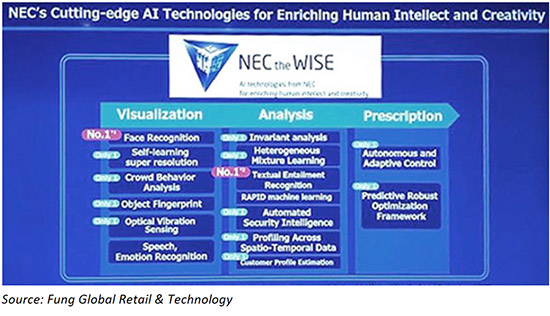
Katsumi Emura, Executive VP and Chief Technology Officer (CTO) of NEC, hosted a sharing session on NEC’s proprietary AI—NEC the WISE. NEC the WISE includes facial-, speech- and emotion-recognition technologies, as well as crowd-behavior analysis and heterogeneous mixture learning, among others. NEC the WISE is helping NEC clients deal with real world problems such as crime prevention, power demand forecasting and the inspection of deterioration in bridges. When asked about the biggest challenges to AI development, Emura pointed out that hardware has not yet fully leveraged the power of AI, adding that the effort and time to educate people about AI is massive. He also stressed the importance of quality data when it comes to AI, as this is what will likely determine the quality of the AI itself rather than factors such as computational power.
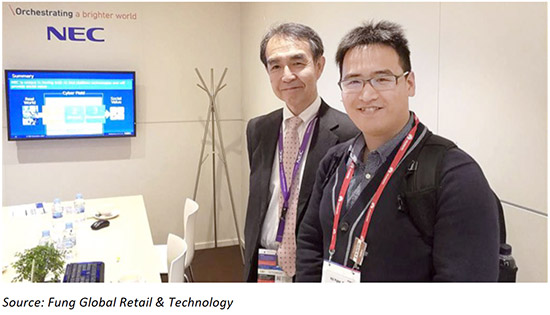
 Conversocial
Conversocial
Conversocial is a SaaS company that provides social customer service solutions. The software helps corporates identify customers that require service via scanning social media platforms and offers a seamless solution for service agents to engage with them. We met with CEO and Co-Founder, Joshua March, who shared with us that the vision of Conversocial is to offer seamless customer service on social media using chatbot technology. He said AI will likely revamp the entire customer service industry in the next 3–5 years. Not only can chatbots provide cost-saving solutions to enterprises, but they also enhance engagement with consumers. March said that solution providers such as Salesforce and Oracle do not focus on customer service via messaging, which he believed is the trend going forward, and hence the opportunity for Conversocial. The company provides a glimpse into the possibility of using AI to turn customer service via social media into loyalty.
Olay: A Beauty Company on an AI Mission
With the launch of the Olay Skin Advisor, Olay is looking to leverage the power of AI to transform the way women shop for beauty products. shopping for beauty products has become increasingly more complex, with more brands and products to choose from. This means that one-third of women leave the store without finding what they are looking for, and 60% of beauty shoppers have in their cabinet at home the so called “skincare graveyard” of products they bought but don’t use, according to the principal scientists at Olay Dr. Frauke Neuser. The promise AI has is that it can solve some of these real pain-points for consumers.
The Olay Skin Advisor is a web-based app that analyzes the user’s skin type and makes personalized recommendations on a beauty regimen and products. How it works is the user uploads a selfie and answers a set of questions designed by beauty scientists to help the algorithm determine the ‘visible skin age.’ The app then recommends products based on its findings. The app’s technology was trained on more than 50,000 faces and will continue to learn every time a new selfie is processed.
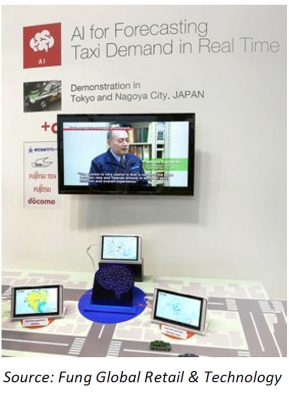 NTT DoCoMo Showcased AI for Forecasting Taxi Demand in Real Time
NTT DoCoMo Showcased AI for Forecasting Taxi Demand in Real Time
By combining the historical data of taxi demand with location and external data, such as population statics and weather forecasts, NTT DoCoMo’s AI product forecasts taxi demand in Tokyo. The project started in June 2016, and has been in field trials since December 2016. The AI can predict taxi demand over a 30-minute period in a 500 square meter area with an accuracy that averaged 92.9%. NTT DoCoMo claims there is a 49% increase in sales performance between those taxis equipped with the forecasting technology and those which do not make use of it.
Samsung’s Nexshop Solution
We saw demos of Samsung’s impressive in-store retail solution suite Nexshop. The company has developed three applications―Nexshop Sales, Nexshop Marketing and Nexshop Training―which are focused on improving in-store performance by providing store associates a mobile POS solution, a marketing tool and a training app with its very own AI learning assistant. The Nexshop solution provides detailed analytics on footfall together with heat-mapping visualizations, which, in some cases, can be broken down to the product level.
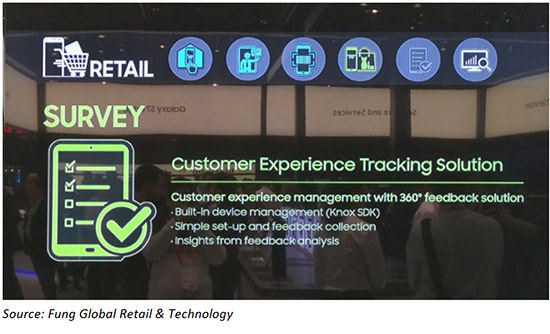
Virtual Reality and Augmented Reality
In a panel by moderated by David MacQueen from Strategy Analytics, Hugo Swart (Qualcomm), Eric Trabold (Avegant) and Tony Chao (Applied Ventures) discussed the hardware challenges for VR and AR adoption as well as their predictions for the development of the two technologies going forward.
The panelists agreed that we are likely to see standalone head mounted display (HMD) VR devices later this year as the next step in the evolution of mobile VR hardware. However, the technology is still bound by limitations of GPU speed, display capabilities and batter life preventing it from being made available through a standalone mobile device that allows freedom of movement and use over a prolonged period of time.
Eric Trabold from Avegant discussed the screenless technology behind Avegant’s first product Glyph, which is a portable personal theater device that was launched at CES, the global consumer electronics and consumer technology tradeshow in Las Vegas. The technology offers one way the display issue could be solved for VR content rendering, as it uses much less power than traditional displays, while providing a higher quality viewing experience.
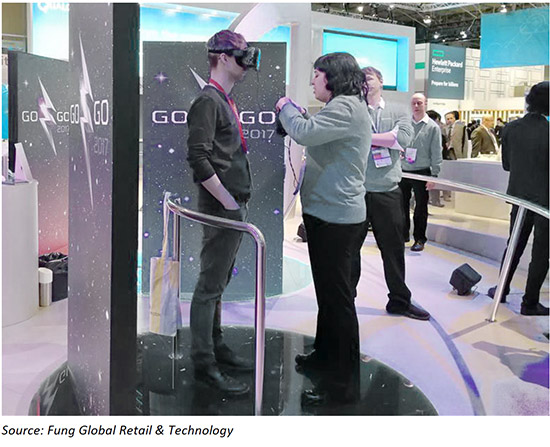
Hugo Swart discussed his view that the future of AR and VR is for the technologies to converge from a user experience point of view―entire scenes of digital content will be accessed through a mobile device with a quality that will be nearly indistinguishable from reality, while full VR immersion is likely to become just one “mode” of the technology that will be used occasionally. In this sense, VR and AR hold great promise to augment reality as we know it, however, all experts seemed to agree that this future is still a long way out
Google’s AR: A Retail Use Case
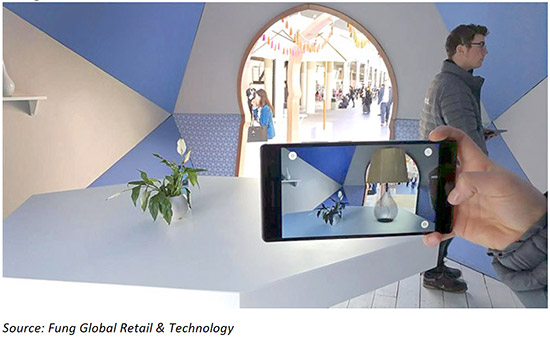
We experienced Google’s Tango technology in retail: the customer makes a product selection and the digital item is superimposed on the physical environment in accurate proportions and correct orientation via AR. The technology worked smoothly and the experience benefited from the display qualities of Google’s new smartphone. In this use case, AR technology on mobile allows customers to browse, view and purchase a much wider range of products than the business physically has in stock.
Wirecard
The Germany-based payment processing and IT company, Wirecard, showcased a VR shopping experience and next-generation mobile POS hardware product that combines a tablet, card scanner and receipt printer.
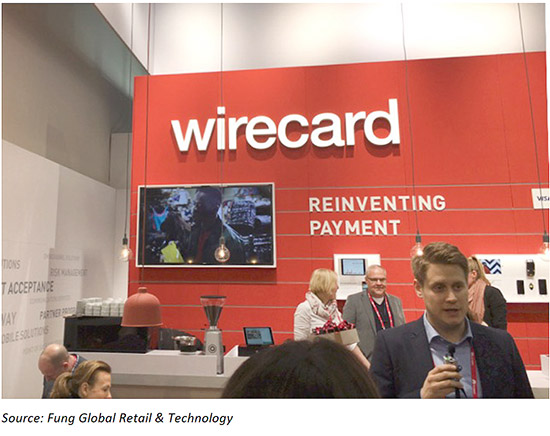
Predictions on future development of VR and AR adoption
In a panel moderated by David MacQueen from Strategy Analytics, Hugo Swart (Qualcomm), Eric Trabold (Avegant) and Tony Chao (Applied Ventures) discussed the hardware challenges for VR and AR adoption as well as their predictions on the development of the two technologies going forward.
The panelists agreed that we are likely to see standalone head mounted display (HMD) VR devices later this year as the next step in the evolution of mobile VR hardware. However, the technology is still bound by the limitations of GPU speed, display capabilities and batter life before it can be made available through a standalone mobile device that allows freedom of movement and use over a prolonged period of time.
Trabold from Avegant discussed the screenless technology behind Avegant’s first product Glyph, which is a portable personal theater device that was launched at the Consumer Electronics Show (CES). The technology offers one way the display issue could be solved for VR content rendering, as it uses much less power than traditional displays, while providing a higher-quality viewing experience.

Swart from Qualcomm discussed his belief that the future of AR and VR is for the technologies to converge from a user experience viewpoint—entire scenes of digital content will be accessed through a mobile device with a quality that will be nearly indistinguishable from reality, while full VR immersion is likely to become just one “mode” of the technology that is used occasionally. In this sense, VR and AR hold great promise to augment reality as we know it, however, all the experts seemed to agree that this future is still a long way out.
Hardware challenges of VR adoption
In order to achieve a highly immersive VR experience, the VR headset needs to achieve the following: high resolution, high pixel density and high framerate. There is an issue with currently available VR headsets called the screen-door effect, which means the pixels are actually visible to users because the lens magnifies them across a wider field of view.

Higher PPI results in higher system memory consumption
To solve the screen door effect, one simple solution is to increase pixels-per-inch (PPI). Most of today’s flagships with a VR-enabled feature have PPI up to 600 pixels. Sharp recently announced a 1,000 PPI IGZO display. However, higher hardware requirements are needed to power high PPI displays.
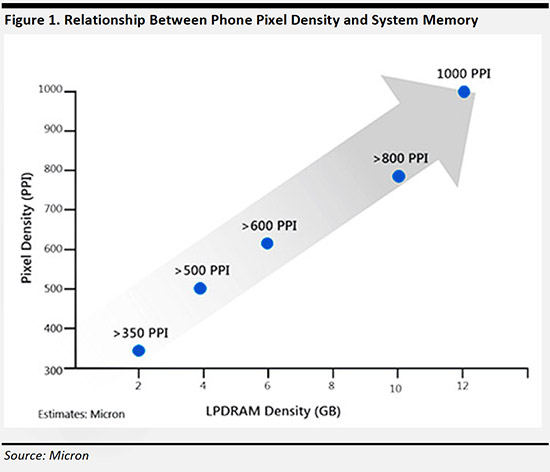
Theoretically, A 1,000 PPI display with a 90Hz refresh rate will be sufficient to deliver a seamless VR experience. According to Micron estimates, in order to run a 1,000 PPI display, a total of 12 GB DRAM is needed (compared to 2GB DRAM in the iPhone 7 and 4GB DRAM in the Galaxy Note 7). Obviously, along with higher system memory, the system will also need better processing power, battery capacity, and the list goes on.

VR remains the center hub of innovative applications of many sectors in the future, yet, there is still a lot of improvement needed to deliver a true VR experience.
Conversational Commerce
Conversational commerce refers to a messaging application that enables shopping, customer service or inquiries. To better cope with changing customer behavior and create better digital engagement, Chatbot, a front-end tool in conversational commerce, integrates the function of advanced messaging with plugins.
Through AI and natural language processing, a chatbot can mimic human interactions to give consumers access to service providers and brands at their convenience.
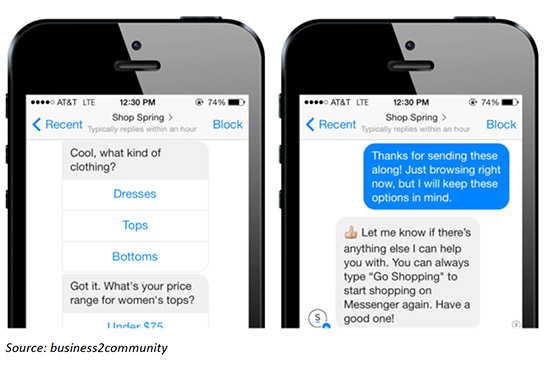
The Future of Chatbots is Voice
John Pulver delivered a session on chatbots and the future of communication. Pulver is the Internet pioneer who is most famous for “the Pulver Order,” which is a ruling by the Federal Communications Commission (FCC) regarding Internet Protocol (IP). The order ruled that computer-to-computer VoIP is not a telecommunications service and so is not subject to traditional voice telecommunications regulation. He commented that 63% of people engage with companies through text or messaging and out of those interactions, 50% are handled by bots. For Pulver, the future belongs to the further automation of these interactions. However, the evolution he is expecting is that rather than using text, people will move on to use voice to converse with machines. In fact, he commented that Gen Z will see the move back to voice communication from the current textual norm, and that AI technology, such as Amazon’s virtual assistant Alexa, will play a big role in that.
The Future of Messaging: Engagement, E-Commerce and Bots
We attended a panel organized by Ovum, which discussed the future of messaging. The panel was moderated by Pamela Clark-Dickson from Ovum and featured Matt Asay, VP of Mobile at Adobe, Mitali Dhar, Director of Global Product Partnership at Google, Beerud Sheth, Co-Founder and CEO of Gupshup, Harper Reed, Senior Director of Software Development at Paypal, and Ryan Sullivan, VP of Product Engineering & Development at Sprint.
The panelists began by discussing the scale of global instant messaging (IM)—the combined user base of Whatsapp, WeChat and Messenger is under 5 billion and the traffic is over 68 trillion messages per year. Discussion then continued around why China and Korea are seeing more success in monetizing IM. Beerud Sheth commented that Asian IM apps are a combination of social media portal and communication tool. Mitali Dhar added there is a need to integrate into one app, which includes chatbots in the future. Messaging apps now include corporate/brand accounts, ads, browsers, chatbots and payment functions. Companies and brands are looking at messaging platforms as their primary engagement platform for their now 24/7 customer relationships. On the development of chatbots within messaging apps, Dhar mentioned that interacting with bots is still different from chatting with friends, and she expects this will be will be the next phase chatbots need to advance to in order to establish a more natural way of communication.
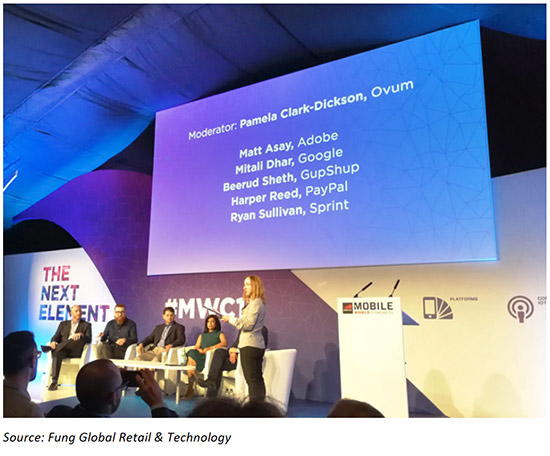
Customer service and commerce via messaging apps creates a unique opportunity to simplify how businesses and consumers interact. Consumers have adopted this new platform, but most companies still need to take the step to messaging and conversational commerce. Matt Asay expressed concern about the negative impact of information silos on messaging—it will be hard to achieve monetization or even implement chatbots in the current messaging ecosystem due the fragmentation of data because of silos.
Other highlights from the show
The Disruptive Impact of Blockchains
Brock Pierce, Managing Partner and Chairman of Blockchain Capital, discussed his view on the opportunities that blockchain technologies present for entrepreneurs and corporates. In his view, blockchain technology is probably the most important technology after the Internet, as it will democratize access to financial services to a large demographic in the currently underserved developing and emerging markets. Furthermore, blockchains and, more specifically, the tokens used to transact on blockchain infrastructure, are likely to revolutionize the way businesses get started and how they raise capital. In 2016, there were 64 ICOs (Initial Token Offerings), which raised over $103 million, and, in some cases, funding rounds were raised in minutes—for example, Golem raised $8.5 million by selling tokens in 19 minutes and SingularDTV raised $7.7 million in 17 minutes.
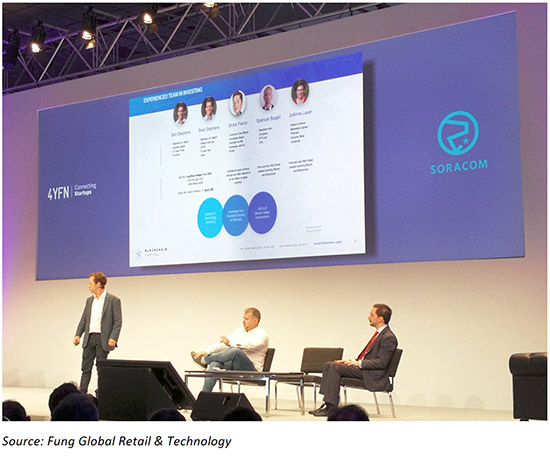
E-Commerce = Content, Community, Marketplace
Uri Levanon, Founder and CEO of Haste Media, delivered a practical guide to the evolution of the e-commerce business model that incorporates content, community and commerce. He looked at examples such as Houzz, Polyvore and TicTail which all leverage the power of content and communities to drive traffic and engagement, which lead to monetization. One example for a successful engagement strategy is the now-global platform for interior design, Houzz, which generates 25 million monthly unique views. According to Levanon, successful e-commerce businesses fall along the “trifecta,” which is defined as the content, community and marketplace segments of the business model.
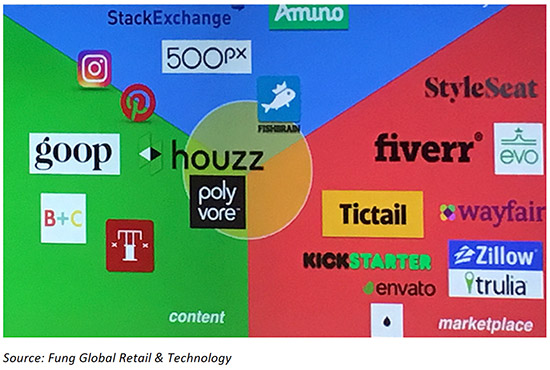
He further pointed out that there are plenty of opportunities to create businesses following this model, and highlighted examples such as Goop and Brit + Co, which were created by Gwyneth Paltrow and Brit Morin, respectively. Both businesses offer users lifestyle guidelines through an authentic voice, lots of content, curated brands and, eventually, private ones.
Ethereum Enterprise Applications and How Organizations Should Think about Data
The session we attended at 4YFN offered a keynote from JP Rangaswami, Chief Data Officer at Deutsche Bank, and a discussion on Ethereum, the general purpose blockchain, with the Foundation Council President of the Ethereum Foundation, Vitalik Buterin.
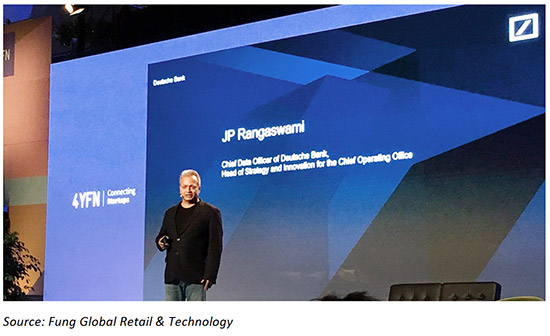
Rangaswami commented on the “digital transformation” resulting from the exponential growth of data and some of the challenges associated with it. According to Rangaswami, there has been a fundamental shift from sellers’ markets, where market transactions are defined by a single provider to many agents, to distributed, or network, models, where the agency is in the hands of consumers. One example is the blockchain, which offers an alternative to centralized book-keeping and verification of virtual transactions and assets. This power shift from centralized organizations to consumers necessitates that organizations break through silo structures in order to adapt to the new market paradigm.
One of the most important aspects of the future role of organizations is how they collect, filter and use data. With the increasing speed and volume of data, the need to verify its accuracy and guarantee its provenance becomes paramount. The main issue stems from the fact that, at present, the time it takes systems to verity the truthfulness of data is, in some cases, longer than the time it takes for the true state of the data to change. In addition, the sheer volume of data creates a filtering problem, if the data is not labeled and organized from the source. As a result, the organization of data has become a priority for businesses across industries, together with the ability to explain why a piece of data is true; in other words, to underwrite the immutability of data throughout its journey, from its source to its end use.
There was a discussion between Buterin and Montserrat Guardia Güell, Digital Challenge Director of Banco Sabadell. With the announcement of the formation of the Ethereum Alliance, which includes companies such as Intel, Mircosoft and J.P. Morgan Chase, the big question on people’s minds was how far away we are from seeing scalable enterprise-level applications run on Ethereum. Buterin was quick to point out that Ethereum is still facing challenges when it comes to overcoming the current technological limitations around the number of transactions and users on its blockchain, but that overcoming these is on the roadmap for the development of Ethereum over the next three to five years. He also pointed out that there are multiple pilots and projects already developed on the blockchain, such as applications governance and voting mechanisms, supply-chain solutions that target provenance and applications in healthcare.
Another Amazon Echo Competitor
The CEO of Line, Takeshi Idezawa, announced today that the Japanese messaging company will be partnering with South Korea’s Naver to launch the digital assistant Clova. In turn, the assistant will power two smart devices, the Wave and the Face, which will be launched later this year. The strategy of the new partnership is to leverage Naver’s dominant position as a leader in search in South Korean and Line’s data and chat capabilities to deliver devices akin to the Amazon Echo and Google Home targeting the Asian consumer.
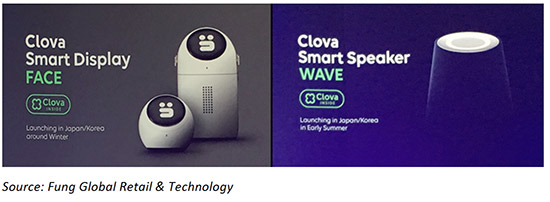
Panasonic
Panasonic is showcasing its connected airport concept at MWC17, and, at the same time, is also exhibiting a suite of hardware and software for retailers:
- A transparent screen which uses projection to create window displays to pull in and engage shoppers.
- A monitoring and managing system that tracks the usage and performance of in-store digital equipment such as displays and signage to optimize maintenance and minimize cost.
- A connected display coupled with facial recognition and RFID product identification.
- Parcel Picking Director, which uses barcode technology to manage key parcel information for a smooth logistics operation. It projects key parcel information onto the parcels themselves, making it viewable from a distance by workers.
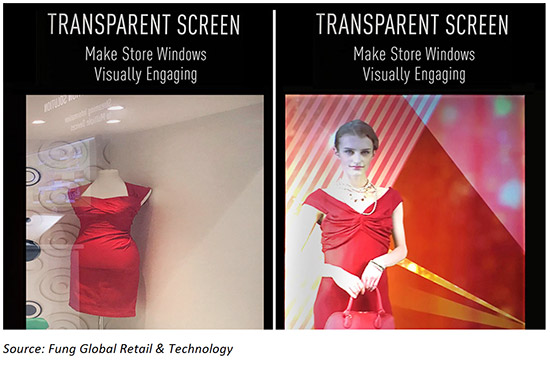
Genesys
The company developed an omnichannel platform that helps retailers interact with the digital consumer. Genesys showcased its chatbot and customer service solutions as well as its platform’s ability to make use of 360-degree view of the consumer with data collected from digital and physical customer touch-points and IoT sensors in retail environments. Marks & Spencer, IKEA, H&M, Nike and Falabella are among the retailers that use the Genesys technology.
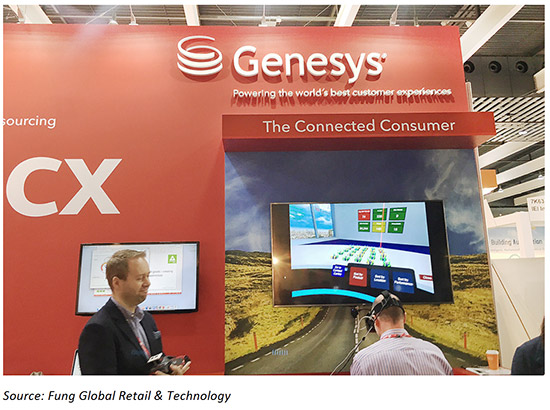
NTS Retail
NTS Retail is an Austrian company that has developed an all-in-one technology retail solution used primarily by mobile operators across Europe. The platform integrates POS, inventory management, aftersales service and retail analytics to allow transactions in both the physical and digital environments.
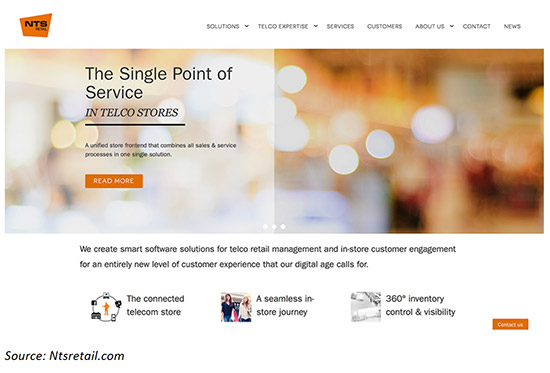
Noticeable Start-ups
AiQ Smart Clothing is a Taiwanese technology and apparel company with a ra nge of products, including a textile RFID, textile heating, washable LEDs and health tracking solutions.
A service that allows prepaid card refills. The technology supports over 140 countries for international mobile recharging by leveraging the Bitcoin infrastructure.
The startup has built a B2B digital platform for companies to brand and customize footwear. All products are produced locally in Spain and the minimum order quantity is 30 pieces. Brand Your Shows has already produced footwear for companies such as SAP, Allianz and Bioderma.
Combyne is a fashion app that lets users store and discover styles. Once they create an outfit users can share it with their followers to gain feedback. The styles available on the app come from over 800 brands and online stores, and the product has gotten positive reviews on the iOS app store since its launch in 2016.
CopSonic is a French company that has developed an ultrasonic alternative to NFC. The technology allows the transmission of data through sound waves, which means it only uses the speakers and microphones of smart devices. Retail use cases of the technology include identity verification, payments and geofencing.
Lechal produces a wearable component that can be integrated in the sole of the shoe or the laces, which allows GPS navigation (via vibration) and fitness tracking. The product was originally designed for people who are visually impaired, but has now been made available to all consumers. The company has already partnered with shoe brand Hi-Tec for its Hi-Tec Navigator Shoes.
A technology that manages how mobile app notifications are pushed to the user, redefining the app customer experience.
A platform to build and manage your conversational strategy. The company builds chatbots that allow companies to have 1:1 interaction with the consumer.
Developed the Superbook, a Universal Laptop Shell for Android, which transforms the android smartphone into a full PC.
A service that allows users in Spain to make peer-to-peer money transfers, such as splitting bills.
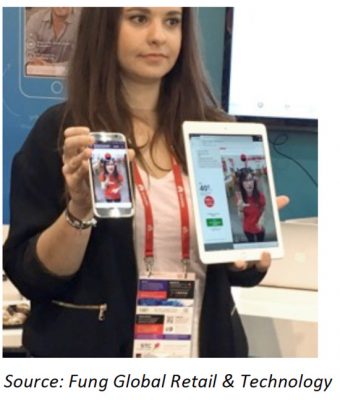 This company showcased a one-to-one and one-to-many video chat tool that integrates directly with a retailer’s website. The tool allows companies to broadcast promotion events or provide live video customer service directly on their website. This boosts engagement and the time users spend on the site, while a lso removing friction from the user experience, since site visitors do not need a separate app or log-in to enter the video chat. The company is already working with mobile operators such as T-Mobile and Vodafone and automakers such as Audi and SEAT, among other companies. These brands have at least doubled their sales conversion rate and experienced a 600% increase in customer engagement.
This company showcased a one-to-one and one-to-many video chat tool that integrates directly with a retailer’s website. The tool allows companies to broadcast promotion events or provide live video customer service directly on their website. This boosts engagement and the time users spend on the site, while a lso removing friction from the user experience, since site visitors do not need a separate app or log-in to enter the video chat. The company is already working with mobile operators such as T-Mobile and Vodafone and automakers such as Audi and SEAT, among other companies. These brands have at least doubled their sales conversion rate and experienced a 600% increase in customer engagement.
Key Takeaways
This year’s theme is more about how applications can take advantage of the well-established mobile ecosystem. We believe AI is going to revolutionize the retail landscape and bring to consumers a highly connected and efficient shopping experience in the coming years. The very front end of AI applications is likely to be the chatbot, and we already saw a number of companies incorporating chatbots in their products. VR and AR are still in the spotlight, yet again we feel it is no more than a gimmick at this point.











